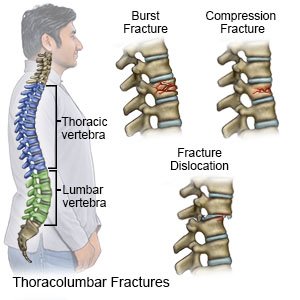Thoracolumbar Fracture
Medically reviewed by Drugs.com. Last updated on Aug 4, 2025.
A thoracolumbar fracture is a break in a thoracic or lumbar vertebrae. The thoracic vertebrae are the 12 bones between your neck and lower back. They are connected to your ribs and help the ribs move when you breathe. The lumbar vertebrae are the 5 bones between your chest and hips. When a vertebra is damaged, the spinal cord may also be damaged.
 |
DISCHARGE INSTRUCTIONS:
Call your local emergency number (911 in the US) if:
- You feel lightheaded, short of breath, or have chest pain.
- You cough up blood.
- You have trouble moving your legs.
- Your legs feel numb or you cannot move them.
Return to the emergency department if:
- Your arm or leg feels warm, tender, and painful. It may look swollen and red.
Call your doctor or orthopedist if:
- You have pain or swelling on your back that is worse or does not go away.
- You have questions or concerns about your condition or care.
Medicines:
You may need any of the following:
- NSAIDs , such as ibuprofen, help decrease swelling, pain, and fever. This medicine is available with or without a doctor's order. NSAIDs can cause stomach bleeding or kidney problems in certain people. If you take blood thinner medicine, always ask if NSAIDs are safe for you. Always read the medicine label and follow directions. Do not give these medicines to children younger than 6 months without direction from a healthcare provider.
- Acetaminophen decreases pain and fever. It is available without a doctor's order. Ask how much to take and how often to take it. Follow directions. Read the labels of all other medicines you are using to see if they also contain acetaminophen, or ask your doctor or pharmacist. Acetaminophen can cause liver damage if not taken correctly.
- Take your medicine as directed. Contact your healthcare provider if you think your medicine is not helping or if you have side effects. Tell your provider if you are allergic to any medicine. Keep a list of the medicines, vitamins, and herbs you take. Include the amounts, and when and why you take them. Bring the list or the pill bottles to follow-up visits. Carry your medicine list with you in case of an emergency.
Activity:
- Avoid activities that may make the pain worse, such as picking up heavy objects. When your pain decreases, begin normal, slow movements as directed by your healthcare provider.
- Ask your healthcare provider when you can begin to exercise. Together you can plan a safe exercise program that can help strengthen your back.
- You may sleep better by doing the following:
- Sleep on a firm mattress. You may also put a ½ to 1-inch piece of plywood between the mattress and box springs.
- Do not use a waterbed, because it will not support your back correctly.
- Sleep on your back with a pillow under your knees to decrease tension on your back. You may also sleep on your side with one or both of your knees bent.
Prevent more injury to your back:
- Lift objects correctly, and use good posture to decrease your risk of injuring your back again. When you pick objects up, bend at the hips and knees. Never bend from the waist only. While you lift the object, keep it close to your chest. Try not to twist or lift anything above your waist.
- Maintain a healthy weight. Being overweight puts more stress on your back.
- Wear low-heeled shoes.
Physical and occupational therapy:
Your healthcare provider may recommend you start or continue one or both types of therapy. A physical therapist teaches you exercises to help improve movement and strength, and to decrease pain. An occupational therapist teaches you new ways to do daily activities after an injury.
Follow up with your doctor or orthopedist as directed:
Write down your questions so you remember to ask them during your visits.
© Copyright Merative 2025 Information is for End User's use only and may not be sold, redistributed or otherwise used for commercial purposes.
The above information is an educational aid only. It is not intended as medical advice for individual conditions or treatments. Talk to your doctor, nurse or pharmacist before following any medical regimen to see if it is safe and effective for you.
Learn more about Thoracolumbar Fracture
Treatment options
Care guides
Symptoms and treatments
Medicine.com guides (external)
Further information
Always consult your healthcare provider to ensure the information displayed on this page applies to your personal circumstances.
